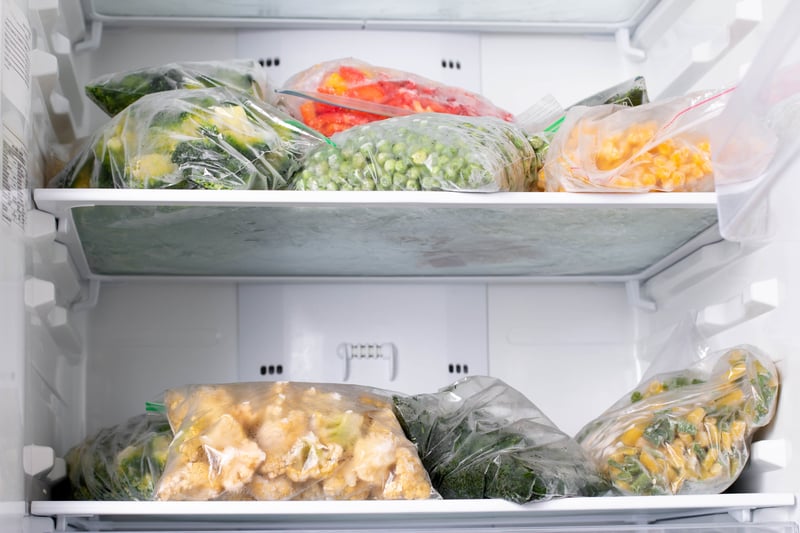12 Foods You Should Never Put in the Freezer

Our freezers are an incredibly useful resource which can save us time, money, as well as some peace of mind. Not only is freezing food one of the oldest methods of naturally preserving food, but by using our freezers, it allows us to reduce food waste while being able to eat a variety of foods through every season.
Additionally, if you are like me and find meal planning difficult, especially when in a time crunch, made-ahead frozen foods can make the dinnertime frenzy a bit more manageable. However, certain foods freeze better than others, and some should just stay out of the freezer altogether.
For example, here are 12 foods you should never freeze:
12 Foods You Should Not Freeze
1. Whole Eggs
Whole eggs should be kept out of the freezer because the egg could expand and crack the shell, allowing bacteria to creep in. Even if the shell doesn’t break, the yolk can thicken and thus become hard to blend with the egg whites. If you want to freeze your eggs, take them out of the shell, beat until they’re well-blended, and store them in an airtight container. Icings, sauces, and other foods made with eggs can also turn rubbery or chewy after spending time in the freezer.
2. Cream-Based Products
Cream-based products like yogurt, sour cream, buttermilk, cream, custard, and other dairy products typically do not hold up well in the freezer. Likely these types of products will separate and curdle after being frozen and thawed.
3. Soft Cheeses
Soft cheeses, like goat, brie, ricotta, and cream cheese also tend to separate and then turn kind of grainy after being frozen. Hard cheeses, like cheddar, hold up better in the freezer; however, they still run a risk of turning mealy after defrosting.
4. Milk
Milk is another food that doesn’t store well in the freezer as once it thaws, it tends to separate into chunks vs. watery parts. Although it will be safe to eat, the consistency is not at all attractive or suitable for adding to your morning cereal or coffee. However, thawed milk can still work for cooking and baking.
5. Mayonnaise
Mayonnaise will look normal while frozen, but once it starts to thaw, the texture will change from creamy to clumpy. Even though it is safe to eat, as the mayonnaise thaws, the emulsion of oil, egg yolks, lemon, and seasonings will break, leaving you with oil floating on top of the yolk base. You could attempt to return it to its original texture, but it likely won’t work. And even if it’s does come close, it’s still likely to be thinner and watery and not very appetizing.
6. Raw Potatoes
Potatoes have a high-water content, so after being stored in the freezer, you could be left with soft potatoes. Even more, thawed raw potatoes can become discolored and, in some cases, turn black, rendering them inedible. You can, on the other hand, freeze cooked potatoes that have been blanched, mashed, roasted, or made into hash browns.
7. Whole Bananas
Overripe bananas keep well in the freezer—you can then add them to smoothies to make them creamier or use them in banana or zucchini bread or even as the sweetener for “breakfast” cookies or muffins. Although you can freeze bananas in the peel, you’ll save yourself some time, effort, and serious frustration if you remove the peels before freezing. When frozen, banana peels turn dark (or even black) and turn soft and thin. While still safe to eat, this makes the peels very difficult to remove. Save yourself the hassle and freeze your peeled bananas in a freezer-safe bag or container until ready to use.
8. Coffee
Despite what you may have heard, coffee beans or grounds should not be stored in the freezer. This is because taking them in and out every day will freeze and thaw the coffee, causing condensation to ruin it. Plus, coffee will absorb any smells from your freezer. You can, however, store unopened bags of coffee beans or grounds in the freezer for up to a month.
9. Water-Rich Produce
Some produce, especially fruits and vegetables with high water content, will become limp, soggy, and possibly have a change in flavor or smell after freezing and thawing. This includes produce such as salad greens, cucumbers, and melon, which are all better off kept in the fridge.
10. Spices
Freezing does not extend the shelf-life of spices and causes taste and flavor changes. Garlic, pepper, and imitation vanilla will become bitter. Whereas onion and paprika may change flavor and curry is known to develop a musty off-flavor.
11. Canned Food and Beverages
When liquid freezes, it expands. This means anything in a can will expand and likely explode, leaving you with a big mess to clean up. This applies to canned goods such as beans and corn as well as carbonated beverages you may be trying to quickly cool in the freezer. (A better option is to just submerge your beverage to cool in ice water in a cooler.)
12. Jelly
Jelly does not freeze well as the chemical bonds that make gelatin are broken when frozen. As a result, it becomes a liquid mess when you defrost it.
Tips for Freezing Foods
Although this is just a short list of foods that do not do well in the freezer, there are still many foods that hold up great. So, on the flip side, when it comes to things that can withstand the freezer, frozen food will keep for around three months before starting to show signs of freezer burn. And some foods may last even longer, even up to nine months to a year due to the variation among different food items.
Nevertheless, the longer food is kept in the freezer the color, flavor, and texture will start to deteriorate. To keep your food in peak freshness, here are some freezer-friendly tips:
- Use a thermometer to monitor your freezer. Freezer temperature should be 0° F (-18° C).
- Make sure everything is frozen in a sealable container or bag.
- Try to get most of the air expelled from the storage container to avoid freezer burn.
- Portion, label, and date frozen foods made for future meals.
- Never refreeze raw meat that has been frozen and then thawed.
- When freezing liquids, leave a little space for expansion.
- Blanch vegetables before freezing to extend their shelf life.
- Keep the freezer two-thirds full for energy efficiency, and leave some room around your food, so the cold air has the opportunity to circulate.
How to Thaw Frozen Foods Properly
Further, when it comes to defrosting your freezer bounty, here are three safe methods of thawing frozen food.
Refrigerator: Defrosting in the refrigerator is the safest method, but it’s also the slowest, so plan ahead. Smaller items can defrost overnight, but most items take a day or two.
Cold water: This type of defrosting requires less time but more attention. Place food in a watertight plastic storage bag and then place the bag in cold water. Change the water at least every 30 minutes until food is thawed.
Microwave: Using the defrost setting on the microwave is a great option for last-minute thawing of small items. Unwrap the food and make sure you use a microwave-safe dish. Then cook the food directly after defrosting.
All around, freezing is a convenient and advantageous option. But before sticking just anything in there, you want to make sure it will come out just as great as when it went in. An easy trick if you’re ever not sure how something will do in the freezer is simply to try freezing a small portion and see if it works.





 7 Signs Your Body is Seriously Low on Collagen (not just wrinkles)
7 Signs Your Body is Seriously Low on Collagen (not just wrinkles) Health Expert: "Turmeric Doesn't Work (unless...)"
Health Expert: "Turmeric Doesn't Work (unless...)" 3 Warning Signs Your Probiotic Supplement is a Total Waste
3 Warning Signs Your Probiotic Supplement is a Total Waste

